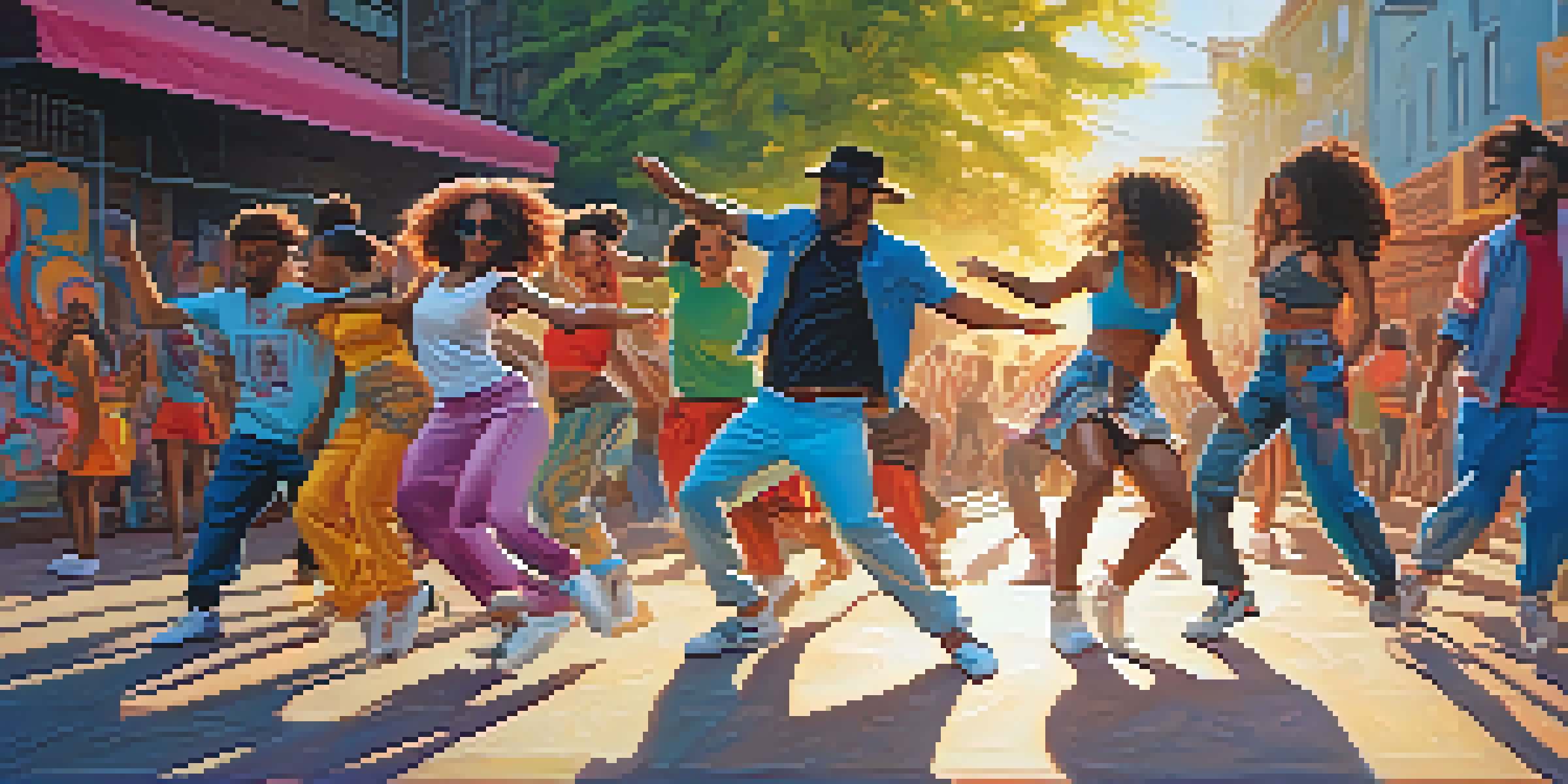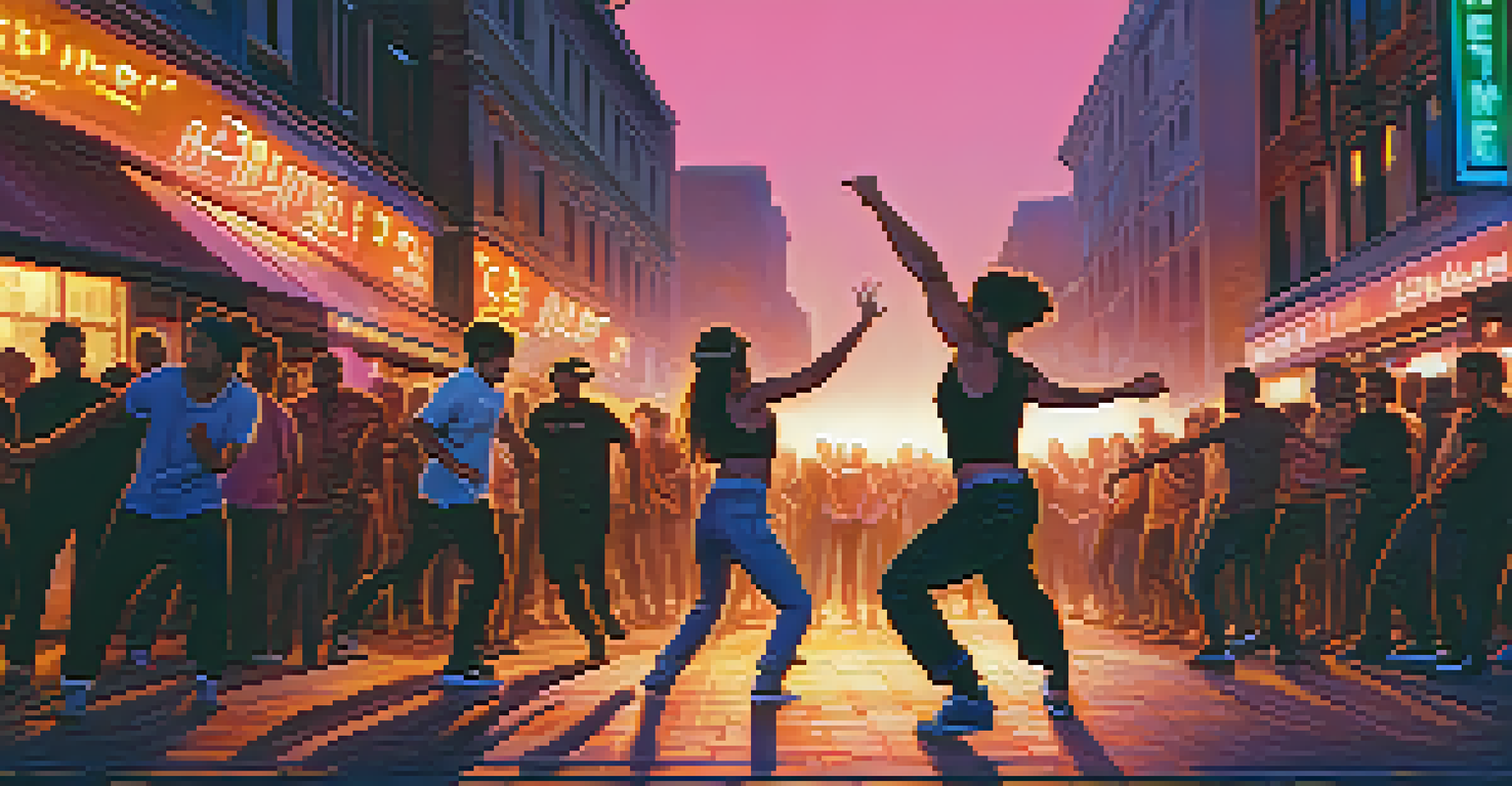The Role of Street Dance in Urban Youth Culture

Understanding Street Dance: A Cultural Movement
Street dance is more than just a style of movement; it's a vibrant cultural phenomenon that has roots in urban communities. Emerging from the streets, it embodies the creativity and struggles of youth facing societal challenges. This art form allows individuals to express their experiences, dreams, and frustrations through the rhythm of their bodies.
Dance is the hidden language of the soul.
From breakdancing in the Bronx to krumping in Los Angeles, street dance styles reflect the diverse backgrounds of those who create and perform them. Each movement tells a story, making it a powerful means of communication. In this way, street dance serves as a unifying force, bringing together young people from various walks of life.
Moreover, street dance often acts as a voice for the marginalized, providing a platform to challenge stereotypes and promote social change. As youth engage in this dynamic form of expression, they not only connect with their cultural roots but also contribute to a broader dialogue about identity and community.
Street Dance as a Form of Identity Expression
For many urban youth, street dance serves as a vital part of their identity. It allows them to showcase their individuality and personal style while connecting with others who share similar passions. Through dance battles and performances, young dancers express their unique stories, building a sense of pride in who they are.

Often, this expression goes beyond mere movement; it encompasses fashion, music, and attitude, creating a holistic cultural experience. The attire worn during performances, for instance, can reflect personal taste and cultural influences, further emphasizing the uniqueness of each dancer. This intersection of various art forms creates a rich tapestry of urban culture.
Street Dance as Cultural Expression
Street dance serves as a powerful medium for urban youth to express their identities, experiences, and cultural narratives.
Additionally, dance communities offer a safe space for self-exploration and acceptance. In these environments, youth can experiment with their identities without fear of judgment, fostering a sense of belonging that is crucial during formative years.
The Community Aspect of Street Dance Culture
Street dance thrives on community engagement, bringing together individuals from diverse backgrounds. Dance crews often form close-knit families, where members support each other in their artistic endeavors and personal lives. This camaraderie fosters a sense of belonging that is essential for many young people navigating the complexities of urban life.
The dance is a poem of which each movement is a word.
Events like dance battles and showcases reinforce this community spirit, as they offer platforms for dancers to demonstrate their skills and celebrate each other's achievements. These gatherings create an atmosphere of encouragement and respect, highlighting the importance of collective growth over individual competition.
Moreover, the collaborative nature of street dance encourages mentorship, with experienced dancers guiding newcomers in honing their craft. This exchange of knowledge not only strengthens the dance community but also builds lasting relationships that extend beyond the dance floor.
Street Dance and Mental Health Benefits
In addition to fostering community, street dance offers significant mental health benefits for urban youth. Engaging in dance can be a powerful outlet for stress relief, allowing individuals to channel their emotions through movement. This physical expression helps to alleviate anxiety and promotes a sense of well-being.
Many young people face various pressures, from academic expectations to social challenges. Street dance provides a constructive way to cope with these pressures, allowing them to escape into a world where they can be free and creative. The joy of dancing can release endorphins, enhancing mood and boosting self-esteem.
Community and Connection in Dance
The street dance culture fosters a sense of belonging and support among dancers, creating close-knit communities that encourage personal growth.
Furthermore, participating in street dance can build resilience, as dancers learn to navigate challenges such as performance anxiety and competition. Overcoming these hurdles not only enhances their skills but also cultivates a positive mindset that can be applied in other aspects of life.
The Role of Social Media in Street Dance Culture
In today's digital age, social media plays a pivotal role in the evolution of street dance culture. Platforms like Instagram and TikTok allow dancers to share their skills with a global audience, transcending geographical boundaries. This exposure not only showcases talent but also inspires others to participate in the dance community.
Social media has also facilitated the rise of viral dance challenges, which often spark interest in street dance among wider audiences. These challenges encourage creativity and collaboration, as dancers put their unique spins on popular choreography. This phenomenon highlights the communal aspect of street dance, as individuals come together to celebrate their shared love for movement.
However, while social media can amplify voices and talents, it also presents challenges, such as the pressure to conform to trends. It's essential for dancers to navigate these influences mindfully, ensuring that their artistry remains authentic and true to their personal expression.
Street Dance as a Tool for Social Change
Beyond personal expression, street dance has the potential to drive social change. Many dancers use their art to raise awareness about issues affecting their communities, from poverty to systemic injustice. Through performances and campaigns, they convey powerful messages that resonate with audiences and inspire action.
Collaboration with organizations and initiatives can amplify these efforts, as dancers partner with community leaders to address pressing issues. Workshops and outreach programs that incorporate street dance promote dialogue and understanding, bridging gaps between different societal groups.
Street Dance Drives Social Change
Through performances and outreach, street dance empowers youth to address social issues and advocate for change in their communities.
By harnessing the power of dance, urban youth can become advocates for change, using their voices and movements to pave the way for a brighter future. This transformative potential reflects the heart of street dance culture, emphasizing its role as both an art form and a catalyst for social progress.
The Future of Street Dance in Urban Youth Culture
As street dance continues to evolve, its influence on urban youth culture remains strong. New styles and trends emerge regularly, reflecting the changing dynamics of society and technology. This adaptability ensures that street dance remains relevant and engaging for future generations.
Furthermore, as more educational institutions recognize the value of street dance, opportunities for formal training and mentorship are increasing. Programs that integrate street dance into curricula offer young people avenues to develop their skills while gaining confidence and discipline.

Ultimately, the future of street dance lies in its ability to inspire, connect, and empower youth. By embracing its roots while exploring new horizons, street dance will undoubtedly continue to play a vital role in shaping urban culture for years to come.